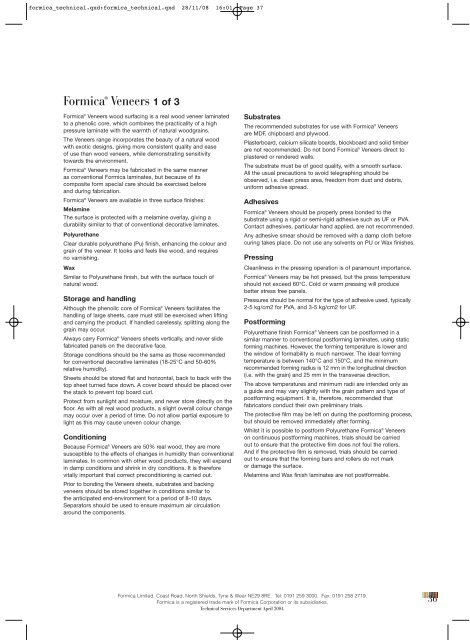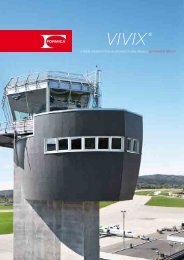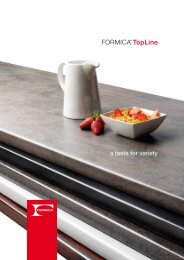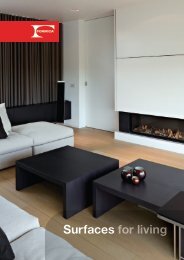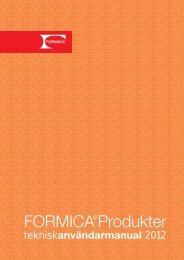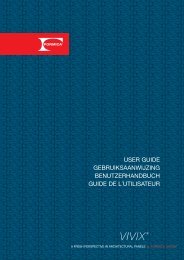Technical Information dispelling traditions - Formica
Technical Information dispelling traditions - Formica
Technical Information dispelling traditions - Formica
Create successful ePaper yourself
Turn your PDF publications into a flip-book with our unique Google optimized e-Paper software.
formica_technical.qxd:formica_technical.qxd 28/11/08 16:01 Page 37<strong>Formica</strong> ® Veneers 1 of 3<strong>Formica</strong> ® Veneers wood surfacing is a real wood veneer laminatedto a phenolic core, which combines the practicality of a highpressure laminate with the warmth of natural woodgrains.The Veneers range incorporates the beauty of a natural woodwith exotic designs, giving more consistent quality and easeof use than wood veneers, while demonstrating sensitivitytowards the environment.<strong>Formica</strong> ® Veneers may be fabricated in the same manneras conventional <strong>Formica</strong> laminates, but because of itscomposite form special care should be exercised beforeand during fabrication.<strong>Formica</strong> ® Veneers are available in three surface finishes:MelamineThe surface is protected with a melamine overlay, giving adurability similar to that of conventional decorative laminates.PolyurethaneClear durable polyurethane (Pu) finish, enhancing the colour andgrain of the veneer. It looks and feels like wood, and requiresno varnishing.WaxSimilar to Polyurethane finish, but with the surface touch ofnatural wood.Storage and handlingAlthough the phenolic core of <strong>Formica</strong> ® Veneers facilitates thehandling of large sheets, care must still be exercised when liftingand carrying the product. If handled carelessly, splitting along thegrain may occur.Always carry <strong>Formica</strong> ® Veneers sheets vertically, and never slidefabricated panels on the decorative face.Storage conditions should be the same as those recommendedfor conventional decorative laminates (18-25°C and 50-60%relative humidity).Sheets should be stored flat and horizontal, back to back with thetop sheet turned face down. A cover board should be placed overthe stack to prevent top board curl.Protect from sunlight and moisture, and never store directly on thefloor. As with all real wood products, a slight overall colour changemay occur over a period of time. Do not allow partial exposure tolight as this may cause uneven colour change.ConditioningBecause <strong>Formica</strong> ® Veneers are 50% real wood, they are moresusceptible to the effects of changes in humidity than conventionallaminates. In common with other wood products, they will expandin damp conditions and shrink in dry conditions. It is thereforevitally important that correct preconditioning is carried out.Prior to bonding the Veneers sheets, substrates and backingveneers should be stored together in conditions similar tothe anticipated end-environment for a period of 8-10 days.Separators should be used to ensure maximum air circulationaround the components.SubstratesThe recommended substrates for use with <strong>Formica</strong> ® Veneersare MDF, chipboard and plywood.Plasterboard, calcium silicate boards, blockboard and solid timberare not recommended. Do not bond <strong>Formica</strong> ® Veneers direct toplastered or rendered walls.The substrate must be of good quality, with a smooth surface.All the usual precautions to avoid telegraphing should beobserved, i.e. clean press area, freedom from dust and debris,uniform adhesive spread.Adhesives<strong>Formica</strong> ® Veneers should be properly press bonded to thesubstrate using a rigid or semi-rigid adhesive such as UF or PVA.Contact adhesives, particular hand applied, are not recommended.Any adhesive smear should be removed with a damp cloth beforecuring takes place. Do not use any solvents on PU or Wax finishes.PressingCleanliness in the pressing operation is of paramount importance.<strong>Formica</strong> ® Veneers may be hot pressed, but the press temperatureshould not exceed 60°C. Cold or warm pressing will producebetter stress free panels.Pressures should be normal for the type of adhesive used, typically2-5 kg/cm2 for PVA, and 3-5 kg/cm2 for UF.PostformingPolyurethane finish <strong>Formica</strong> ® Veneers can be postformed in asimilar manner to conventional postforming laminates, using staticforming machines. However, the forming temperature is lower andthe window of formability is much narrower. The ideal formingtemperature is between 140°C and 150°C, and the minimumrecommended forming radius is 12 mm in the longitudinal direction(i.e. with the grain) and 25 mm in the transverse direction.The above temperatures and minimum radii are intended only asa guide and may vary slightly with the grain pattern and type ofpostforming equipment. It is, therefore, recommended thatfabricators conduct their own preliminary trials.The protective film may be left on during the postforming process,but should be removed immediately after forming.Whilst it is possible to postform Polyurethane <strong>Formica</strong> ® Veneerson continuous postforming machines, trials should be carriedout to ensure that the protective film does not foul the rollers.And if the protective film is removed, trials should be carriedout to ensure that the forming bars and rollers do not markor damage the surface.Melamine and Wax finish laminates are not postformable.<strong>Formica</strong> Limited, Coast Road, North Shields, Tyne & Wear NE29 8RE. Tel: 0191 259 3000. Fax: 0191 258 2719.<strong>Formica</strong> is a registered trade mark of <strong>Formica</strong> Corporation or its subsidiaries.<strong>Technical</strong> Services Department April 2004.36


